Dell OptiPlex 9010 All-in-One Review: Dell's All-in-One Goes Enterprise
by Dustin Sklavos on September 19, 2012 7:01 AM EST- Posted in
- all-in-one
- Systems
- Dell
- Ivy Bridge
System Performance
The last all-in-one system we reviewed was coincidentally the Dell XPS One 2710, which featured a very similar configuration. The key differences between the XPS One 2710 and the OptiPlex 9010 All-in-One I have on hand today are the SSD in the 9010 and the discrete graphics in the 2710. Keep those in mind when you take a look at the PCMark results below.
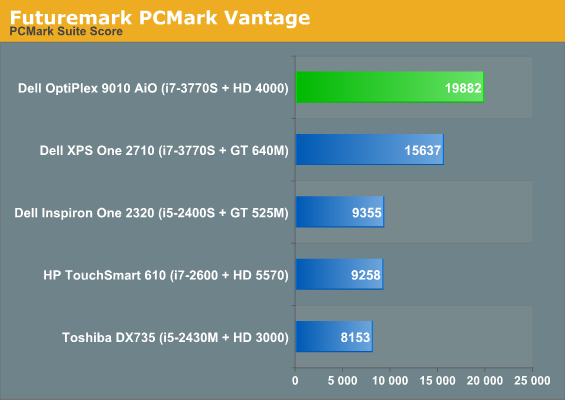
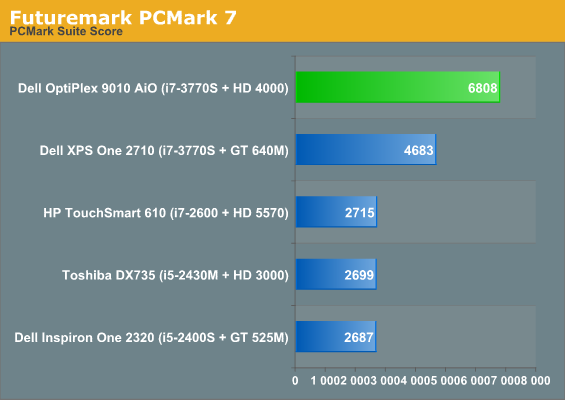
Same processor. Substantially weaker graphics. HUGE swing in scores. This is why I've continued to rail against PCMark in our system reviews; while it's true that an SSD offers a marked improvement in system responsiveness and performance in isolated circumstances, it's not this big of a difference. Anyone looking at this chart would assume the 9010 AiO is worlds faster than the 2710, but take a look at what happens when we put the screws to the CPU.
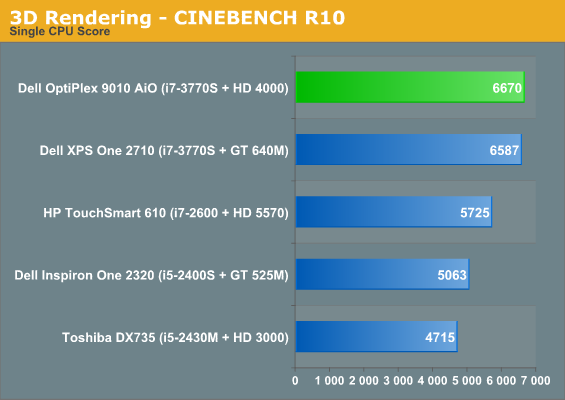
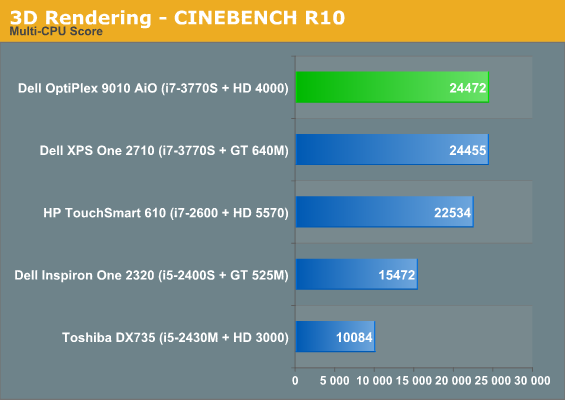

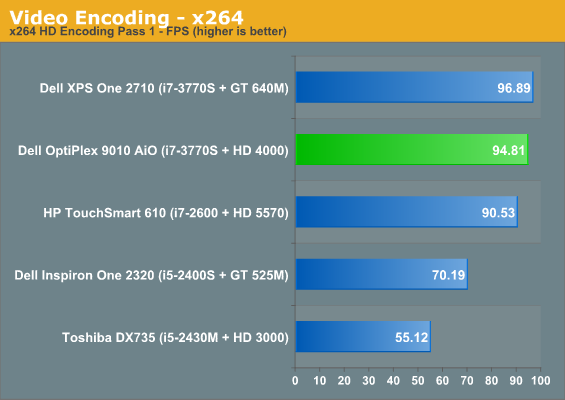

The 2710 and 9010 AiO are virtually identical, as it should be, as they're both running the same CPU. We include PCMark scores for reference, but I'm still of the opinion that they're far too heavily weighted towards storage performance.
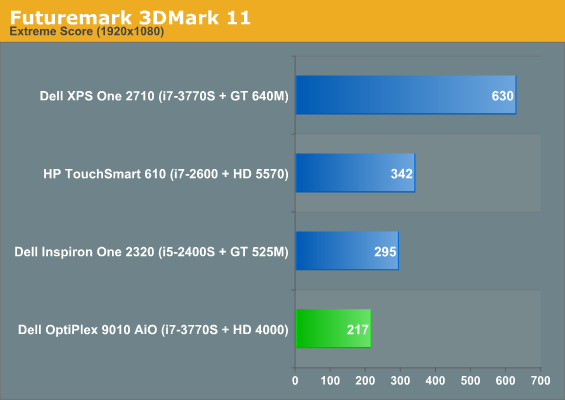
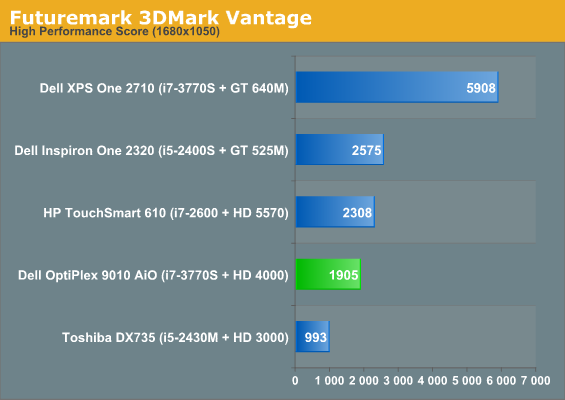

On the other hand, you can see practical evidence that Intel has made some reasonable gains with Ivy Bridge's IGP; in synthetics it starts to encroach on last generation's entry level GPUs. That's not too bad for a GPU you basically get for free. The 9010 AiO is by no means intended for any kind of gaming, but users looking for a quick Guild Wars 2 fix on company time aren't going to be too put out.










21 Comments
View All Comments
NickB. - Wednesday, September 19, 2012 - link
I always heard those poor viewing angles were a "security feature" - how else to explain the consistent use of such panels on business grade laptops?/sarc
Souka - Wednesday, September 19, 2012 - link
we have a number of kiosks at my work for public use.we recently replaced the old 17-19" LCD crap-panels with 22" panels.
Quickly we had requests for privacy screens because the new 22" panels have good viewing angles.
so viewing angle can make a difference.
funny.... but reality....
frozentundra123456 - Wednesday, September 19, 2012 - link
This type of machine is one of the few places in the desktop that I see a good fit for trinity. It would have better gpu performance and "good enough" cpu performance. I am not really a fan of AIO systems in general though. Just seems like too much compromise in performance, upgradability, and repairability for the benefit of saving a bit of space on the desktop.JarredWalton - Thursday, September 20, 2012 - link
And exactly what are you going to do on a kiosk that would benefit from having twice the GPU performance and half the CPU performance? Honestly, I find HD 4000 to be a perfectly adequate solution for everything outside of gaming. A better CPU choice for this system would be the i3-3225 I think -- only two CPU cores, but you don't really need more than that, and at 3.3GHz they're still plenty fast. I've got a system with just such a CPU and with a Samsung 128GB SSD it boots to Windows in about 10 seconds (plus the eight second POST -- I wish motherboard vendors would do more to decrease/eliminate POST times!)Conficio - Wednesday, September 19, 2012 - link
Really what is Dell thinking? Just reading the spec sheet and I see (at least a 1920 x 1080) display, but a TN panel with its bad viewing angles? And the target market of this is kiosk apps, where multiple people might look at a screen and the person's head is likely not aligned with the height of the screen (standing but device on a desk, standing height but people have different height).Try again Dell!
piroroadkill - Wednesday, September 19, 2012 - link
I'm OK with that, but to be honest they need to offer the perfect device for education, which would be a 19" 1440x900 AIO with a Core i3, 64GB SSD, 4GB RAM, perfectly fine if its TN, better, infact, to cut costs.There's a mass market for these kinds of devices, but it's always cheaper to do it from a small manufacturer..
StormyParis - Wednesday, September 19, 2012 - link
Why can't they just make a Thin-ITX monitor stand with a VESA mount and the PC in the base, and let us choose our screen ?piroroadkill - Wednesday, September 19, 2012 - link
You've always been able to buy mini-ITX and mount them to a VESA screen. It's just a matter of options.piroroadkill - Wednesday, September 19, 2012 - link
Also, Dell has offered AIO stands that allow you to bolt an SFF desktop to the back of a screen for a long time, and they're damn convenient, one carry handle, the whole thing.TheSlamma - Wednesday, September 19, 2012 - link
Up till now most of the all-in-one business offerings have been limited. 3gb RAM max, 5400 rpm HD's, Pentium D processors, etc.Now we get Intel vPro (which is much needed for places trying to eliminate desktop visits.) and it addresses the previous limitations I mentioned. It also has high quality NIC and a good wifi card and runs very cool compared to an iMac.
While the display isn't top notch, I don't see a problem with it, the 1080 screen is as good as the standard panels that most companies order with optiplex machines.
While many people don't get the all-in-one, as mentioned int he article one target is public sector, schools, libraries and other local gov do want a smaller footprint. They are trying to do more with the same amount of space when they had Apple ]['s and XT's but with more kids and mobile furniture.
Did I mention how awesome it is to have Intel AMT on these? vPro + RealVNC viewer plus = WIN!!